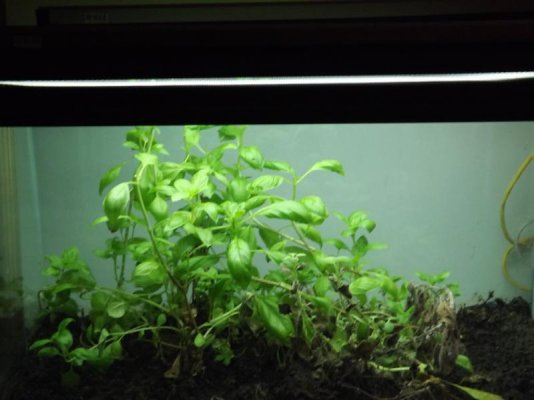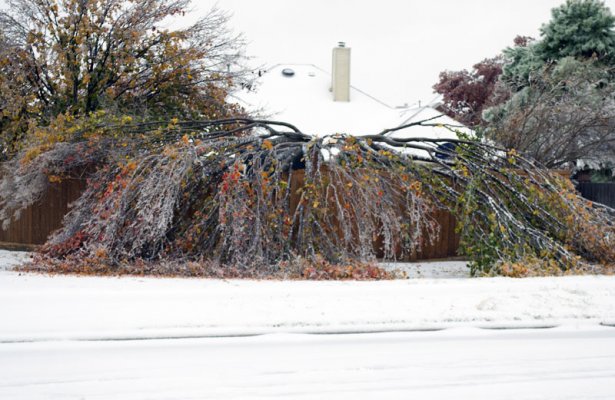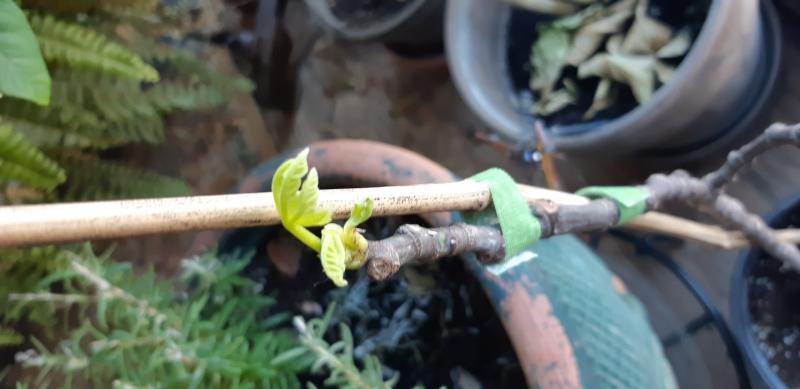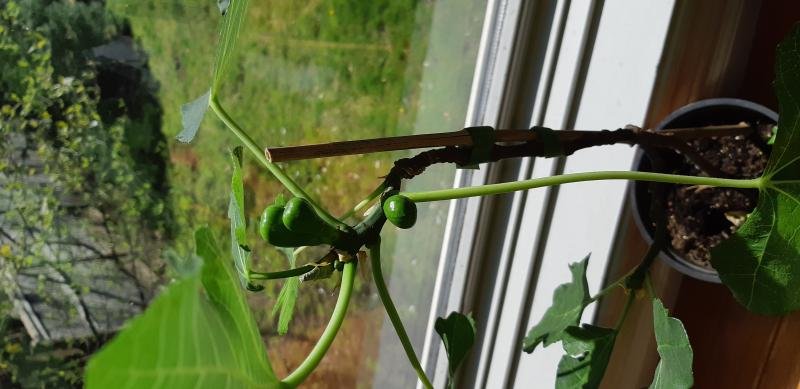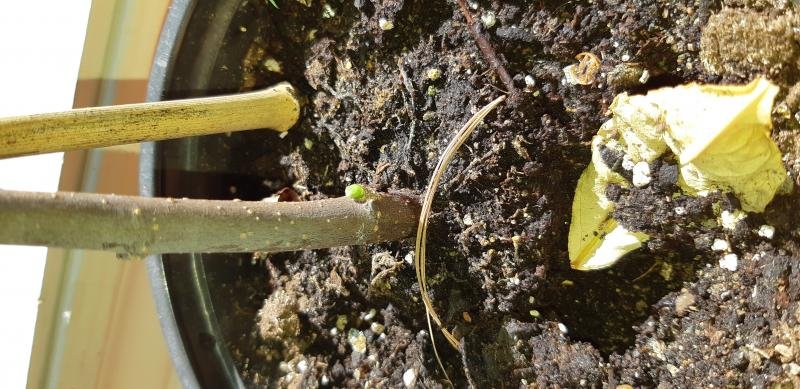You are using an out of date browser. It may not display this or other websites correctly.
You should upgrade or use an alternative browser.
You should upgrade or use an alternative browser.
Fresh herbs year round in northern climate
- Thread starter bradger
- Start date
The friendliest place on the web for anyone that enjoys cooking.
If you have answers, please help by responding to the unanswered posts.
If you have answers, please help by responding to the unanswered posts.
bbqcoder
Senior Cook
What are you using for a lighting setup? How many watts does it use?
Sage is a perennial herb for me. I have it in one of my garden beds and it comes back every year. Same for oregano, thyme, chives, and I'm hoping rosemary. I would like to grow some indoors for year round access to parsley, cilantro, and basil.
Sage is a perennial herb for me. I have it in one of my garden beds and it comes back every year. Same for oregano, thyme, chives, and I'm hoping rosemary. I would like to grow some indoors for year round access to parsley, cilantro, and basil.
tenspeed
Executive Chef
Here's ATK's review...What are you using for a lighting setup? How many watts does it use?
Sage is a perennial herb for me. I have it in one of my garden beds and it comes back every year. Same for oregano, thyme, chives, and I'm hoping rosemary. I would like to grow some indoors for year round access to parsley, cilantro, and basil.
https://www.youtube.com/watch?v=xSdLVT6-Z_M
pepperhead212
Executive Chef
Bradger, Basil and Thai basil are what inspired me to begin growing hydroponics in the off-season, as there is nothing like having the fresh herbs!
I have tried many herbs indoors through the years. I only grew sage when cloning cuttings for others (as bbq noted, it's a perennial, and I don't really need it in the hydro, plus, it is one of many plants that seems to attract spider mites. Just in the short time in the cloner, the spider mites would appear. Others I've grown, which grew vigorously, but attracted the spider mites, were holy basil, rau ram, and rice paddy herb. As soon as these plants were removed, the SMs disappeared - would not spread to everything else. Same thing with spearmint attracting aphids, which would gather on the stems, not the leaves! They would grow like wildfire, yet the aphids would be covering the stems! Yet peppermint never got them.
The basils I have found best for growing indoors are Serrata and Gecofure. Both of these are compact, bushy varieties, the latter a Genovese type, and both with delicious flavors. And for Thai, the Siam Queen has the best flavor, and is the most commonly found variety. Lemon basils grow sort of leggy, and have a tendency to bolt quickly, indoors or out. Here's a photo of some of the overgrown basil in my hydro - the Serrata in the L rear, and the Gefofure that large plant in the front.
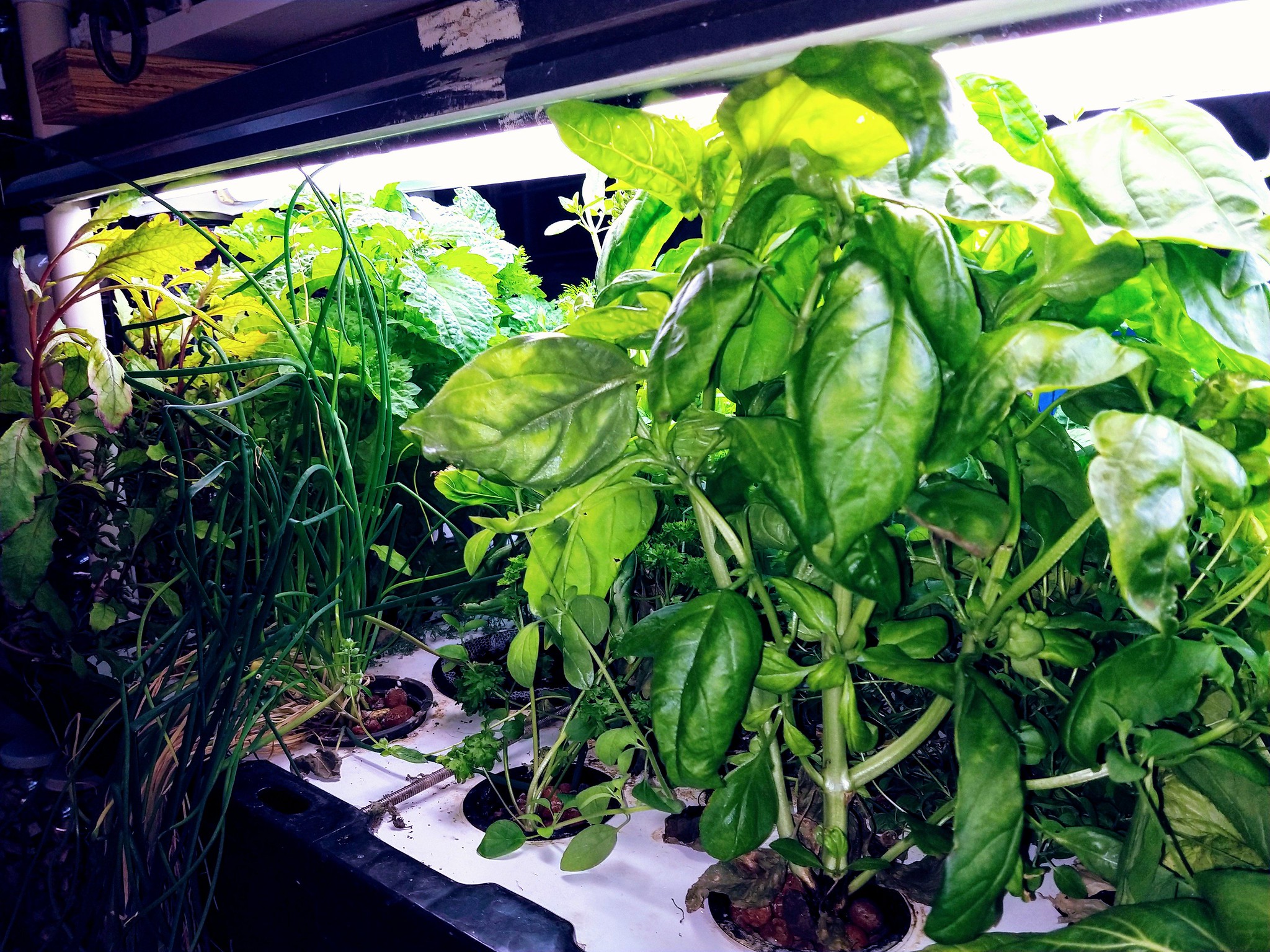 Basil, and some other stuff. by pepperhead212, on Flickr
Basil, and some other stuff. by pepperhead212, on Flickr
Basil does great for about 5-6 months, then begins to go downhill. But I don't need it much past 7 months - I root a bunch of cuttings for outside, and when that takes, the inside stuff isn't used.
Other herbs I have grown indoors are chives, parsley, dill, green perilla, cutting celery, cilantro (can't grow this outside!), epazote, and Syrian oregano, these last two needing frequent trimming. Parsley and cutting parsley get huge roots - I found that curly parsley is better, in that the root system is much smaller. Same thing in soil pots, for the parsley, as the flat leaf gets rootbound quickly. I had 3 plants in a fairly large windowsill box one time, and in early June they were rootbound! The regular curly (not triple) did not do this, even by the end of the season.
Rosemary is something I tried growing indoors many years ago, but it would rootbound within a year, even in a large pot. So I grew it in the garden, and would cover it when temps got under 20°. My old plant died a couple years ago, because the cover blew off, and I couldn't get out to cover it, due to a surgery. So last year I started with 3 new ones, one inside, in a 4 1/2 gal fabric pot, the other two outside, one left uncovered, and it survived 7° temps! The one in the pot did the same thing as before - rootbound in less than a year, but got huge! About 4 times the size of those in the ground. Still, not worth repotting yearly. I'll stick with covering, and hopefully won't have any problems doing that in the future!
I have tried many herbs indoors through the years. I only grew sage when cloning cuttings for others (as bbq noted, it's a perennial, and I don't really need it in the hydro, plus, it is one of many plants that seems to attract spider mites. Just in the short time in the cloner, the spider mites would appear. Others I've grown, which grew vigorously, but attracted the spider mites, were holy basil, rau ram, and rice paddy herb. As soon as these plants were removed, the SMs disappeared - would not spread to everything else. Same thing with spearmint attracting aphids, which would gather on the stems, not the leaves! They would grow like wildfire, yet the aphids would be covering the stems! Yet peppermint never got them.
The basils I have found best for growing indoors are Serrata and Gecofure. Both of these are compact, bushy varieties, the latter a Genovese type, and both with delicious flavors. And for Thai, the Siam Queen has the best flavor, and is the most commonly found variety. Lemon basils grow sort of leggy, and have a tendency to bolt quickly, indoors or out. Here's a photo of some of the overgrown basil in my hydro - the Serrata in the L rear, and the Gefofure that large plant in the front.
 Basil, and some other stuff. by pepperhead212, on Flickr
Basil, and some other stuff. by pepperhead212, on FlickrBasil does great for about 5-6 months, then begins to go downhill. But I don't need it much past 7 months - I root a bunch of cuttings for outside, and when that takes, the inside stuff isn't used.
Other herbs I have grown indoors are chives, parsley, dill, green perilla, cutting celery, cilantro (can't grow this outside!), epazote, and Syrian oregano, these last two needing frequent trimming. Parsley and cutting parsley get huge roots - I found that curly parsley is better, in that the root system is much smaller. Same thing in soil pots, for the parsley, as the flat leaf gets rootbound quickly. I had 3 plants in a fairly large windowsill box one time, and in early June they were rootbound! The regular curly (not triple) did not do this, even by the end of the season.
Rosemary is something I tried growing indoors many years ago, but it would rootbound within a year, even in a large pot. So I grew it in the garden, and would cover it when temps got under 20°. My old plant died a couple years ago, because the cover blew off, and I couldn't get out to cover it, due to a surgery. So last year I started with 3 new ones, one inside, in a 4 1/2 gal fabric pot, the other two outside, one left uncovered, and it survived 7° temps! The one in the pot did the same thing as before - rootbound in less than a year, but got huge! About 4 times the size of those in the ground. Still, not worth repotting yearly. I'll stick with covering, and hopefully won't have any problems doing that in the future!
Last edited:
bbqcoder
Senior Cook
I only grew sage when cloning cuttings for others
Can you elaborate a bit on how you do cuttings? Is it simple as taking a branch, dip in water & then root powder, then plant in soil?
Let's say that I have a basil plant that has gone to seed or is about to. Could I take a cutting and plant it to get a new plant or will the new plant go to seed right away?
larry_stewart
Master Chef
I just got dill, basil and parsley started in my aquaponics for the fall.
The dill ill let bet big then freeze ( since it freezes so well). The others Ill used and cut as I need it.
I also take cuttings from the sage and rosemary which take nicely in the system. Ill usually transplant them to soil in the spring and get them outside .
I also root Fig tree cuttings in the system. I went from 1 tree to 5 trees this way. I'll probably do it again this year. Not that I need any more fig trees, but it gives me something to do, keeps my thumbs green during the winter months.
The dill ill let bet big then freeze ( since it freezes so well). The others Ill used and cut as I need it.
I also take cuttings from the sage and rosemary which take nicely in the system. Ill usually transplant them to soil in the spring and get them outside .
I also root Fig tree cuttings in the system. I went from 1 tree to 5 trees this way. I'll probably do it again this year. Not that I need any more fig trees, but it gives me something to do, keeps my thumbs green during the winter months.
bradger
Assistant Cook
ddqcoder
i used a basic terrarium set up. i used Ferry Mores 24 watt florescent lights they are set on a timer to have light for 8 hours or full sun. i have something else set up for seed planting. this was an experiment going to add more next year.
I tried growing scallions from the left over bulb after using the rest in a recipe. It didn't survive.
i used a basic terrarium set up. i used Ferry Mores 24 watt florescent lights they are set on a timer to have light for 8 hours or full sun. i have something else set up for seed planting. this was an experiment going to add more next year.
I tried growing scallions from the left over bulb after using the rest in a recipe. It didn't survive.
Last edited:
bradger
Assistant Cook
sorry meant bbqcoder
pepperhead212
Executive Chef
I used to root cuttings in soil, after dipping in rooting powder, but it took several weeks to find out if it had worked; either they finally got some new growths, or the cutting began browning. If you want to root some basil, cut it back, if it flowering all over, and you can't find new growth. Otherwise, cut short pieces, maybe 4", with 2" stripped, for the rooting, dip in the powder or gel, and put in a hole in the soil, and press it around the cutting. Set into an area with indirect lighting for a few weeks, until you begin to see new growth. Carefully transplant to it's final pot, making sure the roots look good.Can you elaborate a bit on how you do cuttings? Is it simple as taking a branch, dip in water & then root powder, then plant in soil?
Let's say that I have a basil plant that has gone to seed or is about to. Could I take a cutting and plant it to get a new plant or will the new plant go to seed right away?
Years ago, they came out with these cloners, small enough for home users, and I got one. It finally bit the dust (it was about 20 years old, so didn't owe me anything!), and I made one, from a 4 gal bucket, drilling holes in the lid. Here are some photos, showing the the holes, with the baskets and rubber inserts, which hold the cuttings when inserted. Inside, a powerhead has an emitter screwed into it, which sprays the cuttings in the baskets. I have seen roots appear in as little as 2 days, and usually in 4 to 5 days, using this. I use a solution called CLONEX, which is the best of the ones I have tried - the owner of the local hydroponics store has given me samples of a number of them, and this is the one I buy. It's not organic, but I'm only using 5 tsp/bucket, and very little gets into the plants, by the time I'm harvesting.
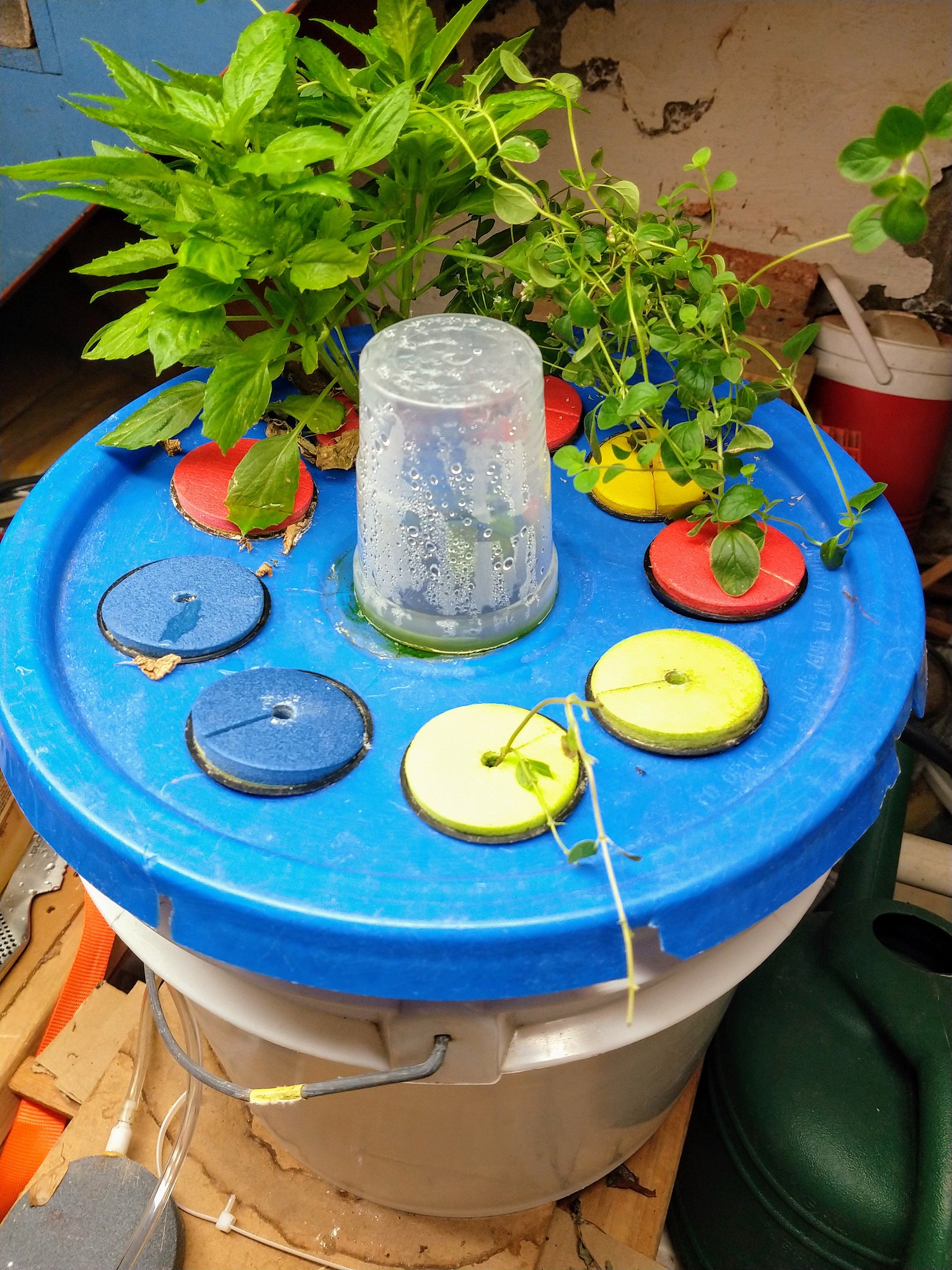 Cloner, with Serrata basil and Syrian oregano rooted, and marjoram cutting just put in front. by pepperhead212, on Flickr
Cloner, with Serrata basil and Syrian oregano rooted, and marjoram cutting just put in front. by pepperhead212, on FlickrYou can't really see the roots in that basil to the left, since it's blurred, but it's there.
 Close-up to cloner, showing the sprayer in the center, and rooted basil. by pepperhead212, on Flickr
Close-up to cloner, showing the sprayer in the center, and rooted basil. by pepperhead212, on FlickrThese roots you can see! All these things were just 3-4" cuttings at first.
 Cloning basket, showing the roots, over 12 inches long. by pepperhead212, on Flickr
Cloning basket, showing the roots, over 12 inches long. by pepperhead212, on FlickrHere are the rooting compounds that I have used. The one on the left - EZ CLONE - seems to work best, though they all work, compared to just putting the cutting in.
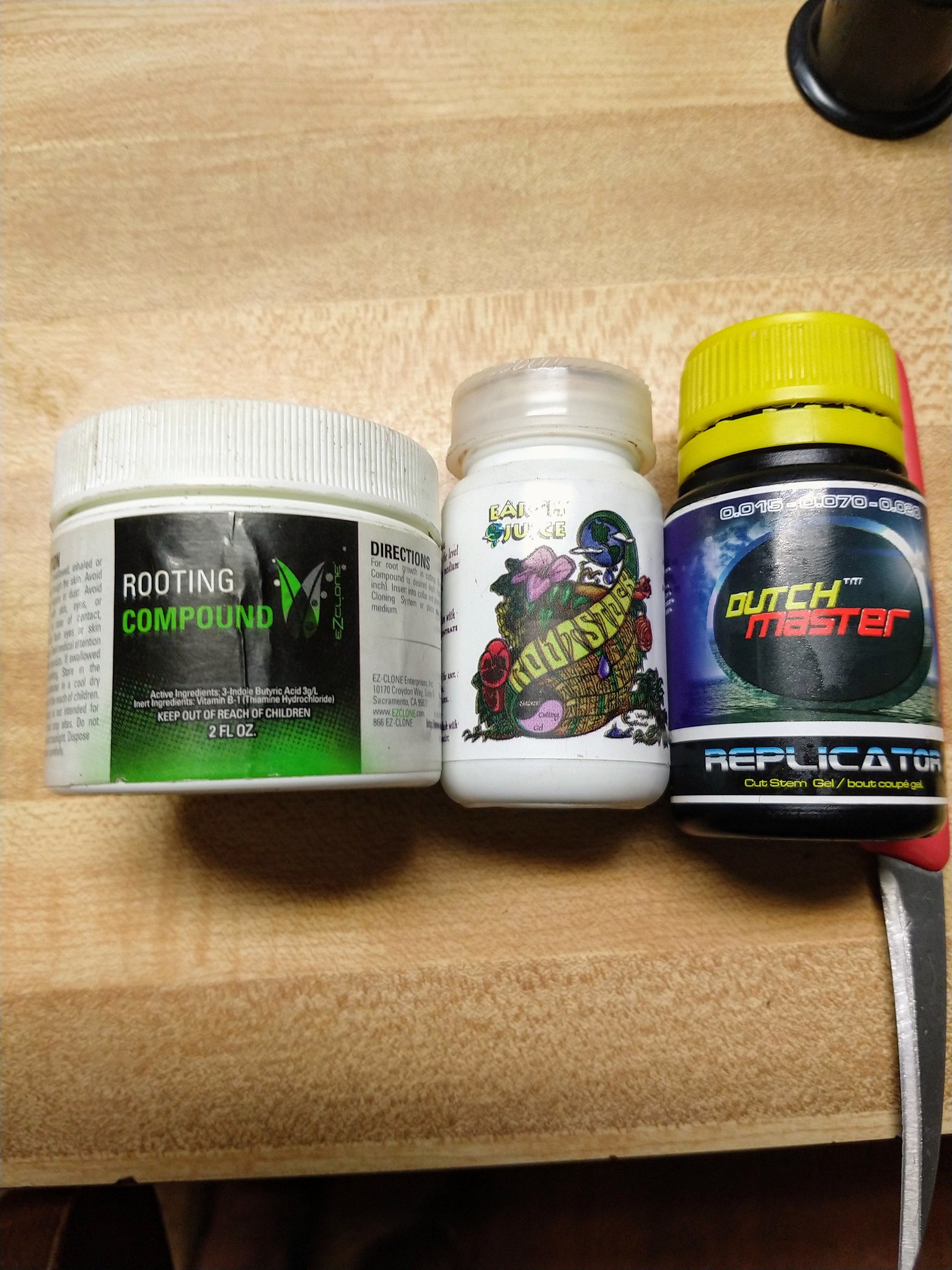 Rooting compounds I have tried, so far. by pepperhead212, on Flickr
Rooting compounds I have tried, so far. by pepperhead212, on FlickrOne thing that roots just as easily just stuck in water, as when I tried it in the cloner, was lemongrass! I just buy a clump of it in the Asian market, cut a small piece off the ends, and pull off the dry skin, then put it in 2" of water, rinsing every 2 days, or so. In 3 weeks, it is ready to plant (though some don't root as well).
Last edited:
I live in Texas, but we get the occasional snow storm here -- maybe one per winter. I know that rosemary, oregano and thyme will survive under six inches of snow, first hand.
Those are the only ones I have personal experience with in snow conditions.
CD
Those are the only ones I have personal experience with in snow conditions.
CD
larry_stewart
Master Chef
in very mild winters I've been able to overwinter my Rosemary ( Up here in New York). Had one that lasted 2 or 3 years. But if we get a real cold one, it usually dies, which is why I always take some late season cuttings and root them for the following year.
Oregano, thyme and sage almost always come back for me ( I root a cutting of sage too)
Parsley kinda survives the winter, even under the snow, but goes to see the following year. But its fun going out and digging it out from under the snow, when I need it in the winter .
Oregano, thyme and sage almost always come back for me ( I root a cutting of sage too)
Parsley kinda survives the winter, even under the snow, but goes to see the following year. But its fun going out and digging it out from under the snow, when I need it in the winter .
in very mild winters I've been able to overwinter my Rosemary ( Up here in New York). Had one that lasted 2 or 3 years. But if we get a real cold one, it usually dies, which is why I always take some late season cuttings and root them for the following year.
Oregano, thyme and sage almost always come back for me ( I root a cutting of sage too)
Parsley kinda survives the winter, even under the snow, but goes to see the following year. But its fun going out and digging it out from under the snow, when I need it in the winter .
I have found that after a few years, rosemary gets rather woody, so I replace it even if it is still alive and growing.
My oregano is probably five years old, and I have to take a weed-whacker to it to keep it from taking over my yard.
CD
bbqcoder
Senior Cook
I live in Texas, but we get the occasional snow storm here -- maybe one per winter. I know that rosemary, oregano and thyme will survive under six inches of snow, first hand.
Those are the only ones I have personal experience with in snow conditions.
CD
Snow is only 32 deg which rosemary can tolerate. It’s when it gets down to the 20s that rosemary will die. I plan to take a cutting indoors but will cover my plant outdoors with some sort of large glass bowl for protection.
Snow is only 32 deg which rosemary can tolerate. It’s when it gets down to the 20s that rosemary will die. I plan to take a cutting indoors but will cover my plant outdoors with some sort of large glass bowl for protection.
Believe it or not, it does get into the 20s in Dallas. The difference may be that the ground doesn't freeze here, so the roots don't freeze.
What we get more often than snow storms, are ice storms. Rain falls and turns to ice when it lands on surfaces. It does most of its damage to trees. Things close to the ground fare better.
CD
.
Attachments
Last edited:
bbqcoder
Senior Cook
I also root Fig tree cuttings in the system. I went from 1 tree to 5 trees this way. I'll probably do it again this year. Not that I need any more fig trees, but it gives me something to do, keeps my thumbs green during the winter months.
Are fig trees easy to grow indoors? Then you bring them outside during the warmer months? How much does a small tree produce?
larry_stewart
Master Chef
Theoretically, they can be left outside all year. Just need to heavily wrap them up ( ive seen several different methods).
All that being said, Ive never been successful wrapping them up. They come back ( the roots and base are still vital) but season is too short so ill get a bunch of figs that are about 2 weeks away from fully ripe, when the frost kicks in.
Ive seen people in different towns maybe 1/2 hour away that have had more success. Maybe their trees are in a better location, shielded from their house or whatever.
So, I do keep one of them in a pot. I prune it back about 2/3, I keep it outside as long as I can before it gets below freezing. At this point, it has no leaves. I bring it in , in a dormant state and keep it that way until march'ish. At that point I place it in front of a window and the leaves and new branches do their thing. In April , get it outside and this extra few weeks to develop has allowed me to pick ripe figs.
I don't get many.
I now have 4 or 5 from the cuttings and put it on a south facing area right up against the house. Im hoping this sheltered area my get me those few extra weeks I need to get ripe figs. Find out next year
All that being said, Ive never been successful wrapping them up. They come back ( the roots and base are still vital) but season is too short so ill get a bunch of figs that are about 2 weeks away from fully ripe, when the frost kicks in.
Ive seen people in different towns maybe 1/2 hour away that have had more success. Maybe their trees are in a better location, shielded from their house or whatever.
So, I do keep one of them in a pot. I prune it back about 2/3, I keep it outside as long as I can before it gets below freezing. At this point, it has no leaves. I bring it in , in a dormant state and keep it that way until march'ish. At that point I place it in front of a window and the leaves and new branches do their thing. In April , get it outside and this extra few weeks to develop has allowed me to pick ripe figs.
I don't get many.
I now have 4 or 5 from the cuttings and put it on a south facing area right up against the house. Im hoping this sheltered area my get me those few extra weeks I need to get ripe figs. Find out next year
Bitser
Senior Cook
Built a year-round greenhouse ten years ago, after battling our savage local climate. Besides having ripe tomatoes for Christmas, it's also good for growing kitchen herbs.
For basil, I seed it thick and then do the first cut at about 5-6 inches. This basil (R) is ready to be cut. So is the flat-leaf parsley (L). For drying, the herbs get bundled and hung in the cool closet under the basement stair.

Cutting the tallest stems of basil releases the smaller plants for fast growth. A planter will usually yield four cuttings before getting scrubby.
Here (L to R) are barely-visible thyme, oregano, marjoram, and sage.

Once dried, the stems get picked out and the leaves are rubbed through an old colander, while I read the news on my iPad.

It's time to process and bottle the summer's harvest: love the aroma!
For basil, I seed it thick and then do the first cut at about 5-6 inches. This basil (R) is ready to be cut. So is the flat-leaf parsley (L). For drying, the herbs get bundled and hung in the cool closet under the basement stair.

Cutting the tallest stems of basil releases the smaller plants for fast growth. A planter will usually yield four cuttings before getting scrubby.
Here (L to R) are barely-visible thyme, oregano, marjoram, and sage.

Once dried, the stems get picked out and the leaves are rubbed through an old colander, while I read the news on my iPad.

It's time to process and bottle the summer's harvest: love the aroma!
Last edited:
Theoretically, they can be left outside all year. Just need to heavily wrap them up ( ive seen several different methods).
All that being said, Ive never been successful wrapping them up. They come back ( the roots and base are still vital) but season is too short so ill get a bunch of figs that are about 2 weeks away from fully ripe, when the frost kicks in.
Ive seen people in different towns maybe 1/2 hour away that have had more success. Maybe their trees are in a better location, shielded from their house or whatever.
So, I do keep one of them in a pot. I prune it back about 2/3, I keep it outside as long as I can before it gets below freezing. At this point, it has no leaves. I bring it in , in a dormant state and keep it that way until march'ish. At that point I place it in front of a window and the leaves and new branches do their thing. In April , get it outside and this extra few weeks to develop has allowed me to pick ripe figs.
I don't get many.
I now have 4 or 5 from the cuttings and put it on a south facing area right up against the house. Im hoping this sheltered area my get me those few extra weeks I need to get ripe figs. Find out next year
Last year I bought a 2 year old fig tree from a home grower in Ste Lazare, Quebec. We have pretty cold winters (-20) but in the middle of town he's probably a couple of degrees warmer. When I went to get it I could not believe his yard... all fig trees in various sizes and his garage was full of pots in various sizes. Some were huge - 20/25' !!
When they get too big to carry in and out for the winter, he plants them in the ground, builds a frame around them for the winter with plastic wrap.
They can winter over at 40 to 55 F. He brings in the potted ones to his garage for the winter. I was going to leave mine out with the chickens and then changed my mind and brought it into my den at the farm.
It survived the rough move to Ontario this summer and still produced 4 figs. One is still green and I think it will probably stay that way - doesn't seem to want to ripen.
Attachments
Sorry, pics were taken a while ago and I can't change their direction.
First one taken in January, coming back to life.
Next in May, producing first 3 figs.
Last one shows a little sprout starting at the bottom. I called the guy for advice and he said to pinch it off to give the rest of the tree more energy.
First one taken in January, coming back to life.
Next in May, producing first 3 figs.
Last one shows a little sprout starting at the bottom. I called the guy for advice and he said to pinch it off to give the rest of the tree more energy.
GinnyPNW
Master Chef
Most herbs freeze pretty well. They may not look the same and one probably would not want to use them without cooking them, but they act pretty much the same as fresh, when cooked.
I freeze a lot of basil, for when my gardens are down. I love fresh basil!
I like MIgardeners tips for pruning to increase harvests...
https://www.youtube.com/watch?v=Hs4VcI8hfYc
https://www.youtube.com/watch?v=OP828jTDlgw
I freeze a lot of basil, for when my gardens are down. I love fresh basil!
I like MIgardeners tips for pruning to increase harvests...
https://www.youtube.com/watch?v=Hs4VcI8hfYc
https://www.youtube.com/watch?v=OP828jTDlgw
Similar threads
- Replies
- 0
- Views
- 238
- Replies
- 34
- Views
- 5K

